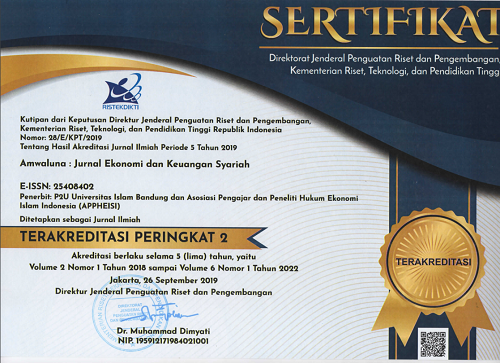SUPER EFISIENSI DAN ANALISIS SENSITIVITAS DEA: APLIKASI PADA BANK UMUM SYARIAH DI INDONESIA
Abstract
The framework for measuring the performance of Islamic banks is related to the concept of efficiency that has been widely implemented. However, there is a deficiency of the DEA model, especially in determining the best ranking of the DMU when there are several DMU units which are equally worth 1. In this study, Islamic banks in Indonesia were used as objects of study. After calculating the super efficiency, then the research will measure the level of influence of each variable on the relative efficiency value through sensitivity analysis. The results showed that, in super efficiency the highest value was owned by BSM bank in 2016 with a relative efficiency value of 1,351, followed by Bank Mega Syariah 2016 with 1,202 and BMI 2016 of 1,175. For sensitivity analysis, the efficiency value of Islamic banks was very sensitive to value output variables, especially operating income variables.
Keywords
Full Text:
PDFReferences
Andersen, P. and Petersen, N.C. (1993), “A procedure for ranking efficient units in data envelopment analysis”, Management Science, Vol. 39, pp. 1261-1264.
Ascarya & Yumanita, D. (2007). Comparing the Efficiency of Islamic Banks in Malaysia and Indonesia. Paper presented at IIUM International Conference on Islamic Banking and Finance (IICiBF): Research and Developement between Ideals and Realities. IIUM – Kuala Lumpur, 23-25 April.
Berger, A. N., & Humphrey, D. B. (1997). Efficiency of financial institutions: International survey and directions for future research. European Journal Operational Research, 98, 175–212.
Berger, A. N., Hancock, D., & Humphrey, D. B. (1993). Bank efficiency derived from the profit function. Journal of Banking and Finance, 17, 317-347.
Charnes, A., Cooper, W.W., and Rhodes, E. (1978). Measuring the Efficiency of Decision Making Units. European Journal of Operation Research, Vol. 2, No. 6, pp. 429-44
Coelli, T.J, Rao, D.S.P., Prasada Rao, Christoper J. O’Donnel and G.E. Battese. (2005). Introduction to Efficiency and Productivity Analysis, (Second Edition), Kluwer Academic Publishers, Boston.
Cooper, William W, Lawrance M. Seiford and Joe Zhu. (2010). Handbook on Data Envelopment Analysis. London: Springer.
Farrell, M.L. (1957). The Measurement of Productive Efficiency. Journal of The Royal Statistical Society, 120, p.253-281.
Hadad, M.D., Santoso, W., Mardanugraha, E., & Illyas, D. (2003). “Analisis Efisiensi Industri Perbankan Indonesia: Penggunaan Metode Nonparametrik Data Envelopment Analysis (DEA)”. Biro Stabilitas Sistem Keuangan Bank Indonesia. Research Paper, 7/5.
Islamic Banker Association. (2017). Global Islamic Finance Report 2017.
Nurfalah, I., Rusydiana, A.S., Laila, N., and Cahyono, E.F. (2018), “Early warning to banking crises in the dual financial system in Indonesia: The markov switching approach”, JKAU: Islamic Economics, Vol.31, No.2, pp.133-156.
Otoritas Jasa Keuangan. (2018). Statistik Perbankan Syariah Indonesia April Tahun 2018.
Ozdemir, Asli. (2013). “Integrating analytic network process and data envelopment analysis for efficiency measurement of Turkish commercial banks”. Banks and Bank Systems Volume 8 issue 2, 2013.
Rusydiana, Aam S. (2019). “Efisiensi sosial dan finansial bank syariah di Indonesia: Pendekatan nonparametrik”. Riset Akuntansi dan Keuangan Indonesia, Vol. 4, No 1, pp.13-25.
Rusydiana, Aam Slamet (2018a). “Efisiensi dan Stabilitas Bank Umum Syariah di Indonesia”, Akuntabilitas, Vol.11, No.2, pp.203-222.
Rusydiana, Aam Slamet (2018b). “Indeks Malmquist untuk Pengukuran Efisiensi dan Produktivitas Bank Syariah di Indonesia”, Jurnal Ekonomi dan Pembangunan Vol. 26, No. 1, pp.47-58.
Rusydiana, Aam Slamet & Sanrego, Yulizar D. (2018). “Measuring the Performance of Islamic Banking in Indonesia: An Application of Maslahah Efficiency Quadrant (MEQ)”, Journal of Islamic Monetary Economics and Finance, Vol. 3 Special Issue, pp.103-130.
Rusydiana, Aam Slamet & Firmansyah, Irman. (2017). “Efficiency versus Maqasid Sharia Index: An Application on Indonesia Islamic Bank”. Shirkah Journal of Economics and Business, Vol 2 No 2, pp. 139-166.
Rusydiana, Aam S, and Taufik Nugroho, (2017). “Measuring efficiency of life insurance institution in Indonesia: Data envelopment analysis approach”. Global Review of Islamic Economics and Business, Vol. 5 No. 1, pp.12-24.
Rusydiana, Aam S., Hasna Maliha and Salman Al Parisi, (2016). “Efficiency measurement of zakat institution program: Case study dompet dhuafa Indonesia”. International Journal of Islamic Business Ethics, Vol. 1, No. 1, pp.28-43.
Sarifudin, M., and Faturohman, T. (2017), “Spin-off efficiency analysis of Indonesian Islamic banks”, Journal of Business and Management, Vol.6, No.2, pp.192-202.
Shahreki, Javad, Nazar Dahmardeh and Mohammad Ali Ghasemi. (2012). “Efficiency Evaluation Bank Sepah Branches in Sistan and Baluchestan Province Using Data Envelopment Analysis”. Interdisciplinary Journal of Contemporary Research in Business Vol. 4 No. 2, June 2012.
Siswadi, Erwinta., R. Nugroho Purwantoro (2005), “Paradigma baru pengukuran efisiensi kinerja relatif berbasis pendekatan matematik”, Manajemen Usahawan No. 06 TH XXXIV Juni 2005.
Tsolas, Ioannis E. and Dimitris I. Giokas. (2012). “Bank branch efficiency evaluation by means of least absolute deviations and DEA”. Managerial Finance Vol 38 No. 8.
Yotopolous, P. A., and L. J. Lau (1973) A Test for Relative Economic Efficiency: Some Further Results. American Economic Review 63:1, 214–223.
Yulita, I., and Rizal, S. (2016), “Islamic banking efficiency: Comparative studies between Malaysia and Indonesia”, Signifikan: Jurnal Ilmu Ekonomi, Vol. 5(1), pp.31-50.
DOI: https://doi.org/10.29313/amwaluna.v4i1.5251
Refbacks
- There are currently no refbacks.
Editorial Office:
Syariah Faculty, Universitas Islam Bandung
Jalan Tamansari No. 24-26 Kota Bandung

Amwaluna : Jurnal Ekonomi dan Keuangan Syariah is licensed under a Creative Commons Attribution-NonCommercial-ShareAlike 4.0 International License.







